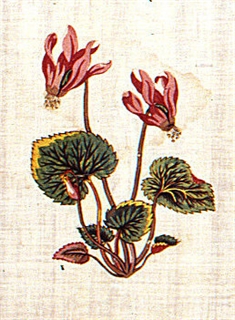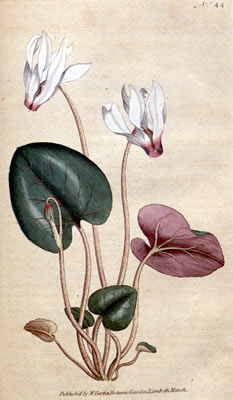Floral Motifs on Early Chintz
Cyclamen sp. - Cyclamen


%20via%20Wikimedia%20Commons_web-WEc8048e1e6d.jpg)
Cyclamen sp. (Cyclamen) on the Unidentified maker, Broderie Perse Tree of Life Counterpane detail, 1790-1815. Cotton 96 1/2 x 92 1/2 in. Collection of Shelburne Museum. 1952-551.
Cyclamen persicum (Cyclamen) from Curtis's Botanical Magazine, vol. 2: t. 44 (1788).
Cyclamen persicum (Cyclamen) growing in modern garden. By MathKnight and Zachi Evenor (Own work) [CC BY 3.0 (http://creativecommons.org/licenses/by/3.0), CC BY-SA 3.0 (http://creativecommons.org/licenses/by-sa/3.0) or GFDL (http://www.gnu.org/copyleft/fdl.html)], via Wikimedia Commons.
Common Names: Cyclamen, or Persian Cyclamen, Sowbread, Ivy-leaved Cyclamen, or Common European Cyclamen depending on the species.
Description: Cyclamen sp. (Cyclamen) is a member of the Primrose Family (Primulaceae). The Hortus Kewensis, ed. 2, vol. 1 recorded that Cyclamen persicum, native to Cyprus, was introduced into cultivation in 1731. The Hortus Kewensis, ed. 2, vol. 1 also recorded that Cyclamen europaeum, native to Austria, was cultivated by 1596 and Cyclamen hederaefolium is a native of Britain. Cyclamen persicum is a likely model for the chintz motif given its publication in Curtis's Botanical Magazine more or less contemporaneously with the printing of the chintz.
Quilts with this Cyclamen sp. (Cyclamen) motif:
Chintz with this Cyclamen sp. (Cyclamen) motif:
© Updated 8/1/2018 Author: Terry Terrell
Description: Cyclamen sp. (Cyclamen) is a member of the Primrose Family (Primulaceae). The Hortus Kewensis, ed. 2, vol. 1 recorded that Cyclamen persicum, native to Cyprus, was introduced into cultivation in 1731. The Hortus Kewensis, ed. 2, vol. 1 also recorded that Cyclamen europaeum, native to Austria, was cultivated by 1596 and Cyclamen hederaefolium is a native of Britain. Cyclamen persicum is a likely model for the chintz motif given its publication in Curtis's Botanical Magazine more or less contemporaneously with the printing of the chintz.
Quilts with this Cyclamen sp. (Cyclamen) motif:
- Shelburne Museum, Broderie Perse Tree of Life Counterpane, Object Number1952-551, Chintz Quilts:Unfading Glory, p. 34, late 18th Century
Chintz with this Cyclamen sp. (Cyclamen) motif:
- None known at this time
© Updated 8/1/2018 Author: Terry Terrell